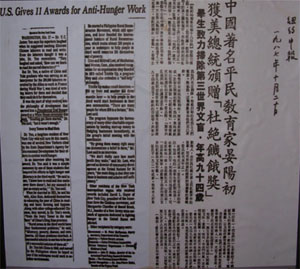 |
|

|
From 1930 to 1936, many people from abroad and at Home Page went to visit Dingxian, where popular education project was carried out. Mr. Dingying, the drama professor in Yale University, highly praised the drama “Transition” performed by local farmers. On Dec 17, 1932, Mr. Edgar Snow reported that Dingxian trail was the most dramatic rural reconstruction in China. American famous education experts also believed that there was much value in our ways of education, including literature and art education to cure ignorance;
|
livelihood education to cure poverty; health education to cure disease; and civic education to cure misgovernment.
In 1942, Japanese education experts began to do research on Dingxian Trial. In 1945, Pearl Buck, the famous American writer, interviewed Yan about his experience of popular education and recorded this part in her book named “Tell the People.” This book had great influence in the world and the UN made the basic worldwide education plan according to it.
In 1980s and 1990s, the research on Yan’s mass education became popular. For example, Charles W ·Hayford focused on Dingxian Trial and wrote “Folk Life: Yan Yangchu and China Rural Areas”. Mayfield put emphasis on the necessary and possibility of long-term development in Chinese rural areas. G.N. Radi summarized the experience in education, livelihood, health and self-government in India. IIRR compiled Y.C.James Yen'S Thought on Mass Education and Rural Reconstruction China and Beyond and Rural Reconstruction Review. |
|
|
 |
|